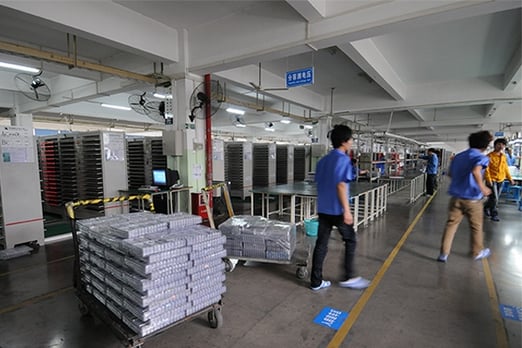Prototype & Production Variations
Take note that it is very common to receive a lot of samples that work great when evaluating them at the prototype level but once production starts you may later find there are problems in the field. These problems are usually due to potential low capacities, life cycle failures, or even workmanship issues.
Suppliers should be providing very clear documentation on each lot of batteries produced to include regulatory transportation certifications, MSDS, capacity testing documentation, and some level of quality auditing. Quality auditing ensures the lots are consistently produced and that the quality checks are being performed at the manufacturing level. Additionally standard practice suggests having the date of manufacturing applied to the batteries for lot traceability.
Battery Transportation & Storage
Battery Manufacturing Facility in Asia
Another important factor to consider is the lithium ion battery transportation and battery storage of the production lots prior to the Original Equipment Manufacturer (OEM) or Contract Manufacturer (CM) receiving the battery packs. Temperature plays a crucial role in battery management. If your production lots are being transported from Asia to the US by ocean freight - there is a possibility that your batteries are being exposed to higher temperature environments. Increased risk if the shipping containers are not air conditioned (which most are not), your batteries could be further exposed to high temperatures during the 6 to 8 weeks they undergo the logistics to arrive.Warehousing is another concern-or whoever the end user is holding the batteries in storage, it is critical to ensure they are stored under ideal climate controlled conditions in low humidity. All batteries have published specifications with operating and storage criteria that should be adhered to. If storage conditions are not met it can lead to higher self-discharge concerns, capacity loss, and greatly reduced cycle life. All which could lead to an unsatisfied customer experience or even recalls.
Summary
In the end, it boils down to understanding how the batteries are being controlled at the manufacturing level. It’s extremely important that overall lithium-ion battery management and logistic procedures are consistently monitored to maintain proper performance of storage at any length. It is recommended that quality audits are performed upon receiving to make certain your production lots meet your requirements. If all these variables are addressed, you will have much more consistency in the results of your battery packs.
Key Takeaways
- Prototype Success Doesn’t Guarantee Production Quality: Batteries that perform well during prototype testing can later fail in production due to inconsistencies in capacity, life cycle, or workmanship. Consistent supplier quality control is critical to long-term performance.
- Documentation Ensures Traceability and Compliance: Reliable suppliers should provide certifications such as MSDS, capacity test data, transportation documentation, and manufacturing data to verify safety and enable lot-level traceability.
- Temperature Control During Transit Matters: Long ocean shipments without proper temperature regulation can expose lithium-ion batteries to heat, causing degradation and potential safety risks during transport.
- Proper Storage Conditions Preserve Battery Life: Batteries stored in uncontrolled environments with high humidity or temperature variation can suffer from self-discharge, capacity loss, and reduced cycle life.
- Ongoing Quality Audits Maintain Consistency: Conducting incoming inspections and regular supplier audits helps ensure production lots meet specifications, maintaining performance and minimizing customer dissatisfaction or recalls.
















